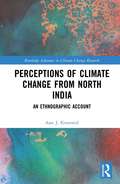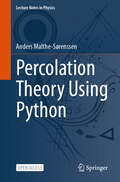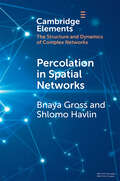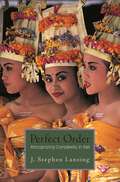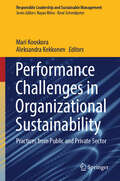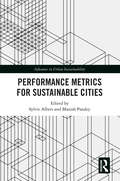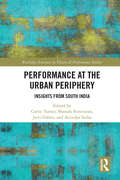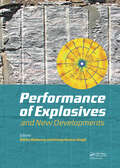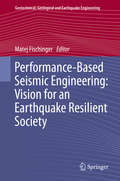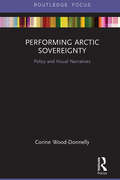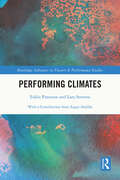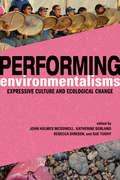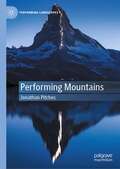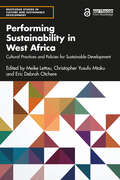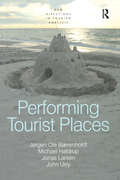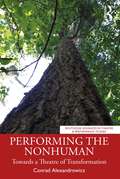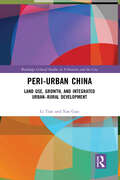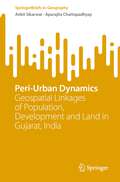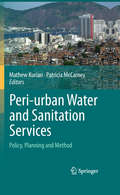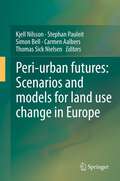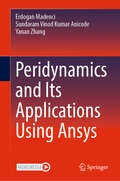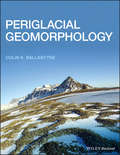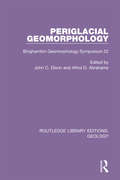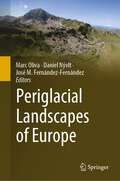- Table View
- List View
Perception, Design and Ecology of the Built Environment: A Focus on the Global South (Springer Geography)
by Mainak GhoshThis edited volume is a compilation of the ‘built environment’ in response to many investigations, analyses and sometimes mere observations of the various dialogues and interactions of the built, in context to its ecology, perception and design. The chapters concentrate on various independent issues, integrated as a holistic approach, both in terms of theoretical perspectives and practical approaches, predominantly focusing on the Global South. The book builds fabric knitting into the generic understanding of environment, perception and design encompassing ‘different’ attitudes and inspirations. This book is an important reference to topics concerning urbanism, urban developments and physical growth, and highlights new methodologies and practices. The book presumes an understanding unearthed from various dimensions and again woven back to a common theme, which emerges as the reader reads through.Various international experts of the respective fields working on the Global South contributed their latest research and insights to the different parts of the book. This trans-disciplinary volume appeals to scientists, students and professionals in the fields of architecture, geography, planning, environmental sciences and many more.
Perceptions of Climate Change from North India: An Ethnographic Account (Routledge Advances in Climate Change Research)
by Aase J. KvanneidPerceptions of Climate Change from North India: An Ethnographic Account explores local perceptions of climate change through ethnographic encounters with the men and women who live at the front line of climate change in the lower Himalayas. From data collected over the course of a year in a small village in an eco-sensitive zone in North India, this book presents an ethnographic account of local responses to climate change, resource management and indigenous environmental knowledge. Aase Kvanneid’s observations cast light on the precarious reality of climate change in this region and bring to the fore issues such as access to water, NGO intervention and climate information for farmers. In doing so, she also explores classic topics in the study of rural India including ritual, gender, social hierarchy and political economy. Overall, this book shows how the cause and effect of climate change is perceived by those who have the most to lose and explores how the impact of climate change is being dealt with on a local and global scale. This book will be of great interest to students and scholars of the anthropology of climate change, environmental sociology and rural development.
Percolation Theory Using Python (Lecture Notes in Physics #1029)
by Anders Malthe-SørenssenThis course-based open access textbook delves into percolation theory, examining the physical properties of random media—materials characterized by varying sizes of holes and pores. The focus is on both the mathematical foundations and the computational and statistical methods used in this field. Designed as a practical introduction, the book places particular emphasis on providing a comprehensive set of computational tools necessary for studying percolation theory. Readers will learn how to generate, analyze, and comprehend data and models, with detailed theoretical discussions complemented by accessible computer codes. The book's structure ensures a complete exploration of worked examples, encompassing theory, modeling, implementation, analysis, and the resulting connections between theory and analysis. Beginning with a simplified model system—a model porous medium—whose mathematical theory is well-established, the book subsequently applies the same framework to realistic random systems. Key topics covered include one- and infinite-dimensional percolation, clusters, scaling theory, diffusion in disordered media, and dynamic processes. Aimed at graduate students and researchers, this textbook serves as a foundational resource for understanding essential concepts in modern statistical physics, such as disorder, scaling, and fractal geometry.
Percolation in Spatial Networks: Spatial Network Models Beyond Nearest Neighbours Structures (Elements in Structure and Dynamics of Complex Networks)
by Shlomo Havlin Bnaya GrossPercolation theory is a well studied process utilized by networks theory to understand the resilience of networks under random or targeted attacks. Despite their importance, spatial networks have been less studied under the percolation process compared to the extensively studied non-spatial networks. In this Element, the authors will discuss the developments and challenges in the study of percolation in spatial networks ranging from the classical nearest neighbors lattice structures, through more generalized spatial structures such as networks with a distribution of edge lengths or community structure, and up to spatial networks of networks.
Perfect Order: Recognizing Complexity in Bali (Princeton Studies in Complexity #11)
by J. Stephen LansingAlong rivers in Bali, small groups of farmers meet regularly in water temples to manage their irrigation systems. They have done so for a thousand years. Over the centuries, water temple networks have expanded to manage the ecology of rice terraces at the scale of whole watersheds. Although each group focuses on its own problems, a global solution nonetheless emerges that optimizes irrigation flows for everyone. Did someone have to design Bali's water temple networks, or could they have emerged from a self-organizing process? Perfect Order--a groundbreaking work at the nexus of conservation, complexity theory, and anthropology--describes a series of fieldwork projects triggered by this question, ranging from the archaeology of the water temples to their ecological functions and their place in Balinese cosmology. Stephen Lansing shows that the temple networks are fragile, vulnerable to the cross-currents produced by competition among male descent groups. But the feminine rites of water temples mirror the farmers' awareness that when they act in unison, small miracles of order occur regularly, as the jewel-like perfection of the rice terraces produces general prosperity. Much of this is barely visible from within the horizons of Western social theory. The fruit of a decade of multidisciplinary research, this absorbing book shows that even as researchers probe the foundations of cooperation in the water temple networks, the very existence of the traditional farming techniques they represent is threatened by large-scale development projects.
Performance Challenges in Organizational Sustainability: Practices from Public and Private Sector (Responsible Leadership and Sustainable Management)
by Mari Kooskora Aleksandra KekkonenThis book conceptualizes and clarifies the meaning of sustainable performance, approaching it holistically from different perspectives. It focuses on challenges related to movements to transform the world economy into more modern, resource-efficient, and competitive, while keeping in mind harmonization of environmental, social, and governance objectives. This has brought along new initiatives and undertakings that invite people, communities, and organizations to participate in building greener and more sustainable future. The book discusses the UN Sustainable Development Goals (SDGs), EU Green Deal and Climate Pact, and Environmental, Social and Governance (ESG) metrics. It tackles policies and strategies that integrate sustainable practices into business activities to align with these goals, focusing on the increasing number of regulations, such as ESG Reporting, Sustainable Finance Disclosure Regulation (SFDR), Corporate Sustainability Reporting Directive (CSRD), and Green Taxonomy. The book highlights new challenges organizations will face as they navigate their way through these goals and regulations, and provides practical coping tips. It is divided into four main parts which consecutively discuss and analyze the concepts and approaches more generally in the first part, challenges, approaches, and metrics on green and sustainable performance on regional and local level in the second part; and on companies' level in the third part; and how top-down (public sector) and bottom-up (private sector) approaches meet. Finally, in the fourth part, the book showcases concrete cases and best practices related to the above-described topics showing how the challenges related to green and sustainable performance have been turned to new opportunities and competitive advantage in different organizations in different industries. The book is a valuable resource for not only academia, researchers, master, and doctoral level students (especially in the sustainability courses), and executive trainings, but also practitioners, politicians, public officials, and organizational leaders interested in turning their organizations into more sustainable units.
Performance Metrics for Sustainable Cities (Advances in Urban Sustainability)
by SylvieManish Albert PandeyPerformance Metrics for Sustainable Cities provides an overview of measurement systems and tools to enable communities to self-assess and benchmark their progress along a continuum of smart, intelligent, and sustainable development. It begins by explaining the importance of measurement and evaluation for cities and smaller communities, as well as future factors that will need to be considered and embedded into planning processes. Across 14 chapters, the book describes existing evaluation mechanisms that are being used for government funding decisions, awards of recognition, and new measurement systems to assess what makes a city smarter and more sustainable, such as broader sustainable goal targets (UN SDGs), green cities, fabrication cities, and compassionate cities. It presents examples of metrics used for important sustainability and liveability concepts for cities such as how to measure trust, engagement, compassion, circular economy, and so forth. The book ends with reflections on the feasibility of a holistic system of measurement and the implications of its implementation. This volume will be of great interest to students, researchers, and professionals of urban sustainability, planning, smart cities, and sustainable communities.
Performance at the Urban Periphery: Insights from South India (Routledge Advances in Theatre & Performance Studies)
by Anindya Sinha Sharada Srinivasan Jerri Daboo Cathy TurnerThis edited volume considers performance in its engagement with expanding Indian cities, with a particular focus on festivals and performances in Karnataka, Tamil Nadu and Kerala. The editors ask how performance practices are affected by urbanisation, the effects of such changes on their cultural economy, and the environmental impacts of performance itself. This project also considers how performance responds to its context, and the potential for performance to be critical of the city’s development, and of its own compromises. Bringing together perspectives from the humanities, natural and social sciences, the book takes a multi-faceted analytical view of live performance, connecting contemporary with heritage forms, and human with more-than-human actors. The three sections, themed around heritage, everyday life, and future ecologies, will be of great interest to students and scholars in performance, heritage studies, ecology and art history.
Performance of Explosives and New Developments
by Vinay Kumar Singh Bibhu MohantyThere is considerable scope for improving the outcome of any blasting operation through basic understanding and application of the principles of blasting science and technology. The main objective of Performance of Explosives and New Developments is to sensitize the practitioner to critically examine the various empirical approaches in blasting whi
Performance-Based Seismic Engineering: Vision for an Earthquake Resilient Society
by Matej FischingerThe Bled workshops have traditionally produced reference documents providing visions for the future development of earthquake engineering as foreseen by leading researchers in the field. The participants of the 2011 workshop built on the tradition of these events initiated by Professors Fajfar and Krawinkler to honor their important research contributions and have now produced a book providing answers to crucial questions in today's earthquake engineering: "What visible changes in the design practice have been brought about by performance-based seismic engineering? What are the critical needs for future advances? What actions should be taken to respond to those needs?" The key answer is that research interests should go beyond the narrow technical aspects and that the seismic resilience of society as a whole should become an essential part of the planning and design process. The book aims to provide essential guidelines for researchers, professionals and students in the field of earthquake engineering. It will also be of particular interest for all those working at insurance companies, governmental, civil protection and emergency management agencies that are responsible for assessing and planning community resilience. The introductory chapter of the book is based on the keynote presentation given at the workshop by the late Professor Helmut Krawinkler. As such, the book includes Helmut's last and priceless address to the engineering community, together with his vision and advice for the future development of performance-based design, earthquake engineering and seismic risk management.
Performing Arctic Sovereignty: Policy and Visual Narratives (Routledge Research in Polar Regions)
by Corine Wood-DonnellyThe Arctic is 5.5 million square miles and has been inhabited by humans for thousands of years, yet it is still a frontier of development. But who owns the Arctic? This book charts the history of performances of sovereignty over the Arctic in the policy and visual representations of the US, Canada and Russia. Focusing on narratives of the effective occupation of territory found in postage stamps, it offers a novel analysis of Arctic sovereignty. Issues such as climate change, plastics pollution and resource development continue to impact the future of this space centred around the North Pole. Who is responsible for the region? This book examines how countries have absorbed Arctic territory into their national consciousness, examining the choice of, and use of, symbols and images in postage stamps. It looks at the story of how these countries have represented their Arctic frontiers and territorial peripheries. The book argues that the performance of policy in these regions has caused relative sovereignty to become a reality. It provides an intriguing account of how these countries have, in their distinctive ways, established, legitimised and reinforced their political authority in these regions. This book will appeal to Geographers and is recommended supplementary reading for students in political history and regional studies of the North.
Performing Climates (Routledge Advances in Theatre & Performance Studies)
by Eddie Paterson Lara StevensPerforming Climates features 13 interconnected essays exploring theatre and performance’s relationship with more-than-human elements at a time of climate emergency. This book argues that Western performance – how we conceive of it, as well as how we train and educate people in and about it – needs to reorient its ways of making and thinking about itself to reconsider patterns of breakdown, decay and renewal happening on and off stage in a literal play of cells and particles. Performing Climates examines live performance as a uniquely compostable artform, formed by sonic vibrations and movements of air and matter, more-than-human elements, composition and decomposition. This book will appeal to undergraduate audiences, postgraduate scholars and performance studies colleagues, offering exciting possibilities for reconsidering theatre and performing in an age of crisis.
Performing Environmentalisms: Expressive Culture and Ecological Change
by Mark Pedelty John Holmes McDowell Jennifer C. Post Aaron S. Allen Jeff Todd Titon Eduardo S Brondizio Assefa Tefera Dibaba Rebecca Dirksen Mary Hufford Chie Sakakibara Rory Turner Lois WilckenPerforming Environmentalisms examines the existential challenge of the twenty-first century: improving the prospects for maintaining life on our planet. The contributors focus on the strategic use of traditional artistic expression--storytelling and songs, crafted objects, and ceremonies and rituals--performed during the social turmoil provoked by environmental degradation and ecological collapse. Highlighting alternative visions of what it means to be human, the authors place performance at the center of people's responses to the crises. Such expression reinforces the agency of human beings as they work, independently and together, to address ecological dilemmas. The essays add these people's critical perspectives--gained through intimate struggle with life-altering force--to the global dialogue surrounding humanity's response to climate change, threats to biocultural diversity, and environmental catastrophe. Interdisciplinary in approach and wide-ranging in scope, Performing Environmentalisms is an engaging look at the merger of cultural expression and environmental action on the front lines of today's global emergency. Contributors: Aaron S. Allen, Eduardo S. Brondizio, Assefa Tefera Dibaba, Rebecca Dirksen, Mary Hufford, John Holmes McDowell, Mark Pedelty, Jennifer C. Post, Chie Sakakibara, Jeff Todd Titon, Rory Turner, Lois Wilcken
Performing Mountains (Performing Landscapes)
by Jonathan PitchesLaunching the landmark Performing Landscapes series, Performing Mountains brings together for the first time Mountain Studies and Performance Studies in order to examine an international selection of dramatic responses to mountain landscapes. Moving between different registers of writing, the book offers a critical assessment of how the cultural turn in landscape studies interacts with the practices of environmental theatre and performance. Conceived in three main parts, it begins by unpicking the layers of disciplinary complexity in both fields, before surveying the rich history and practice of rituals, playtexts and site specific works inspired by mountains. The last section moves to a unique analysis of mountains themselves using key concepts from performance: training, scenography, acting and spectatorship. Threaded throughout is a very personal tale of mountain research, offering a handrail or alternative guide through the book.
Performing Sustainability in West Africa: Cultural Practices and Policies for Sustainable Development (Routledge Studies in Culture and Sustainable Development)
by Meike Lettau, Christopher Yusufu Mtaku and Eric Debrah OtchereThis book discusses the role of cultural practices and policy for sustainable development in West Africa across different artistic disciplines, including performance, video, theatre, community arts and cultural heritage. Based on ethnographic field research in local communities, the book presents findings on current debates of cultural sustainability in Nigeria, Ghana, Cameroon and Benin. It provides a unique perspective connecting cultural studies, conflict studies and practical peacebuilding approaches through the arts. The first part pays particular attention to aspects of social cohesion and the circumstances of internally displaced persons e. g. caused by the Boko Haram insurgency in Northeast Nigeria. The second part focuses on cultural policy issues and challenges in the context of sustainable development, investigating participatory approaches and bottom-up processes, the role of governments and civil society, as well as performing arts organizations and universities in policy making and implementation processes. Performing Sustainability in West Africa presents research results and new methods on the role of artistic and cultural practices in conflict situations as well as current debates in cultural policy for researchers, academics, NGOs and students in cultural studies, sustainable development studies and African studies.
Performing Tourist Places (New Directions in Tourism Analysis)
by John Urry Jørgen Ole Bærenholdt Michael HaldrupThis book looks at the making and the consuming of places in the contemporary world. Illustrated through various case-studies from Denmark, it considers how places, performances and peoples intersect. It examines the fascinating circumstances through which visitors to a place, in part, produce that place through their performances. Places are intertwined with people through various systems that generate and reproduce performances in and of that place. These systems comprise networks of ’hosts, guests, buildings, objects and machines’ that contingently realize particular performances of specific places. The studies featured here develop an exciting ’new mobility’ paradigm emerging within the social sciences.
Performing the Nonhuman: Towards a Theatre of Transformation (ISSN)
by Conrad AlexandrowiczThis book radically reimagines theatre/performance pedagogy and dramaturgy in response to the accelerating climate crisis.This text is founded upon the principle that the theatre is the most anthropocentric of all the arts: the means of its representation, the human figure, is identical with its conventional object, the human narrative, broadly considered. In order to respond ethically to the climate crisis, it must expand its range to include performing as/in response to the nonhuman. Conrad Alexandrowicz concisely explores theoretical approaches to the other‑than‑human, found in the work of, among others, Jane Bennett, Timothy Morton, Rosi Braidotti, and Cary Wolfe. The implications of this move are far‑reaching and commence with displacing realism from its traditional position of dominance. The practices of 20th century physical theatre visionaries such as Tadeusz Kantor, Jacques Lecoq, and Jerzy Grotowski are revisited and reconsidered for their applicability to forms of theatre that might serve the needs of establishing storytelling deriving from nonhuman phenomena. This logically leads to the matter of responding appropriately to Indigenous ways of knowing and being. The work finds guidance in Indigenous, pre‑scientific ways of knowing and being, such as those articulated by Robin Wall Kimmerer (Braiding Sweetgrass, 2013). In contemplating our kinship with vegetative life, the work finds inspiration in the latest research into the ways tree communities communicate, collaborate, and share resources, including the work of Suzanne Simard (Finding the Mother Tree, 2021). It next imagines transformations in how theatre is situated, delivered, and received and considers the ways in which the performer/spectator binary may have to be reconfigured, with particular reference to Grotowski’s experiments in participatory theatre. It poses an even more provocative question: is such theorized performance work pointing in the direction of some re‑imagined version of ritual and ceremony that may find antecedents in pre‑Christian European belief and practice? Finally, it locates such eco‑theatre in the realm of healing: climate anxiety, depression, and grief on the part of instructors, students, and artists will require us to consider and activate the healing power of the art form; perhaps, the core purpose of all the arts will shift to support the need to generate solace in times of fear, anger, and uncertainty.This book is intended for instructors, both scholars and performance pedagogues, in theatre and performance studies, as well as graduate and undergraduate students in these areas.
Peri-Urban China: Land Use, Growth, and Integrated Urban–Rural Development (Routledge Critical Studies in Urbanism and the City)
by Yan Guo Li TianThe urban-rural relationship in China is key to a sustainable global future. This book is particularly interested in peri-urbanization in China, the process by which fringe areas of cities develop. Recent institutional change has helped clarify property rights over collective land, facilitating peri-urban area development. Chapters in this book explore how rural industrialization has changed the landscape and rules about land use in peri-urban areas. It looks at the role of rural industrialization and provides a detailed exploration of peri-urbanization theory, policy, and its evolution in China. Leading discussions find out how fragmented bottom-up industrialization, urbanization, and lax governance have led to a series of social and environmental problems. The progress in redevelopment of peri-urban areas was initially slow due to the spatial lock-in effect. This book offers practical solutions to environmental issues and explains how policymakers have the potential to redevelop a future collaborative, inclusive, and sustainable approach to peri-urban areas. This in-depth approach to urbanization will be useful to academics in urban planning and governmental organizations. It will also be advantageous to NGOs and professionals involved in urban planning, public administration, as well as land-use work in China and other developing countries.
Peri-Urban Dynamics: Geospatial Linkages of Population, Development and Land in Gujarat, India (SpringerBriefs in Geography)
by Ankit Sikarwar Aparajita ChattopadhyayUrban expansion beyond the city’s administrative boundaries has altered villages to a great extent. These peri-urban villages are experiencing unforeseen changes in demographic, economic, land-use, and environmental characteristics. The concept of peri-urbanization is grabbing the attention of urban planners and policymakers globally. To understand the dynamics of the peri-urban region it is crucial to examine multiple rural and urban characteristics. This book studies major changes in population, land and development with the integration of remotely sensed data and census data for 615 peri-urban villages surrounding Ahmedabad city of India. The chapters of the book are designed to cover key aspects of peri-urban change with geospatial methods. This book offers a comprehensive understanding and importance of analyzing peri-urban dynamics at the smallest spatial unit. It provides a detailed conceptual and methodological framework for the students and researchers to study peri-urbanization as well as for the policymakers to redefine the urban policies.
Peri-urban Water and Sanitation Services
by Mathew Kurian Patricia MccarneyMore than 2.6 billion people in the developing world lack access to safe water and sanitation service. The Millennium Development Goal's (MDG) target is to halve the number of people without access to a sustainable source of water supply and connection to a sewer network by 2015. That target is unlikely to be met. If there is anything that can be learnt from European experience it is that institutional reform occurs incrementally when politically enfranchised urban populations perceive a threat to their material well-being due to contamination of water sources.
Peri-urban futures: Scenarios and models for land use change in Europe
by Simon Bell Kjell Nilsson Stephan Pauleit Carmen Aalbers Thomas A. Sick NielsenPresently, peri-urbanisation is one of the most pervasive processes of land use change in Europe with strong impacts on both the environment and quality of life. It is a matter of great urgency to determine strategies and tools in support of sustainable development. The book synthesizes the results of PLUREL, a large European Commission funded research project (2007-2010). Tools and strategies of PLUREL address main challenges of managing land use in peri-urban areas. These results are presented and illustrated by means of 7 case studies which are at the core of the book. This volume presents a novel, future oriented approach to the planning and management of peri-urban areas with a main focus on scenarios and sustainability impact analysis. The research is unique in that it focuses on the future by linking quantitative scenario modeling and sustainability impact analysis with qualitative and in-depth analysis of regional strategies, as well as including a study at European level with case study work also involving a Chinese case study.
Peridynamics and Its Applications Using Ansys
by Yanan Zhang Erdogan Madenci Sundaram Vinod AnicodeThis book introduces a unified implementation of bond- and state-based peridynamic theory (PD) within a commercial finite element framework, Ansys, utilizing its native elements. It details the implementation of the PD theory and its integration with traditional finite elements. The primary objective is to equip students, researchers, and practicing engineers with both theoretical and practical knowledge of the PD theory, along with the skills necessary for analyzing engineering problems using Ansys. The book demonstrates that, unlike the conventional finite element method (FEM), the PD theory is highly suitable for progressive failure analysis, the multi-scale analysis of materials involving fracture and failure, and multi-physics analysis, including electromigration, corrosion, and electrodeposition. Additionally, it provides a step-by-step illustration of the specific procedures in the pre-processing, solution, and post-processing phases of the analysis through the Graphical User Interface (GUI) for various applications. The book is designed to be introductory and self-contained, minimizing the need for additional reference material.
Periglacial Geomorphology
by Colin K. BallantyneA fascinating and informative exploration of periglacial processes, past and present, and their role in landscape evolution Periglacial Geomorphology presents a comprehensive introduction to the processes that operate in present periglacial environments and discusses the inferences that can be drawn about former periglacial environments from those processes. Organized into six parts, the book opens with the historical and scientific context of periglacial geomorphology and the nature of periglacial environments. Following chapters provide systematic coverage of the full range of topics germane to a thorough understanding of periglacial geomorphology, including: The physics of ground freezing and thawing, characteristics of permafrost, and the nature and origin of underground ice Characteristics, formation and significance of landforms, sediments, and structures associated with permafrost, permafrost degradation, and seasonal ground freezing and thawing Rock weathering in periglacial environments, periglacial processes operating on hillslopes, and the characteristic landforms produced by rock breakdown and slope processes in cold environments The operation of fluvial, aeolian and coastal processes in cold environments, and the resulting distinctive landforms and sediments The use of relict periglacial features to reconstruct past cold environments in midlatitude regions and the responses of periglacial environments to recent and predicted climate change Periglacial Geomorphology is an important resource for undergraduate and graduate students studying geomorphology or Quaternary science within the context of geography and geology degree programs. It will be of use to all scientists whose research involves an understanding of cold environments, whether from a geographical, geological, ecological, climatological, pedological, hydrological, or engineering perspective.
Periglacial Geomorphology: Binghamton Geomorphology Symposium 22 (Routledge Library Editions: Geology #25)
by John C. Dixon Abrahams Athol D.This book, first published in 1992, contains the proceedings of the 22nd Binghamton Geomorphology Symposium, and highlights the quantity and diversity of periglacial geomorphic research being undertaken in Arctic and alpine environments. The articles explore a variety of geomorphic processes and examine the potential impacts of global change on the nature and extent of permafrost and seasonal ice phenomena.
Periglacial Landscapes of Europe
by Marc Oliva Daniel Nývlt José M. Fernández-FernándezThis book comprehensively presents the geography of landforms linked to periglacial processes across Europe. The landscape of the European cold climate regions, both at high latitudes and in mountainous environments, represent the lingering, minimal expression of the glaciers. In addition, periglacial elements can be found in temperate regions, where temperatures no longer favor periglacial processes, so landforms are therefore inherited from previous cold phases.The book is divided into five parts: an introductory section on climate variability responsible for periglacial dynamics across Europe; a second part including 3 blocks on periglacial landforms in southern, central and northern Europe; and a final chapter providing a more general perspective on the impact of periglacial processes on the landscape of Europe. The book offers a valuable reference guide for scientists from all disciplines interested in cold climate processes, as well as readers outside academia (territorial managers, environmentalists, mountaineers, politicians, engineers, etc.).

